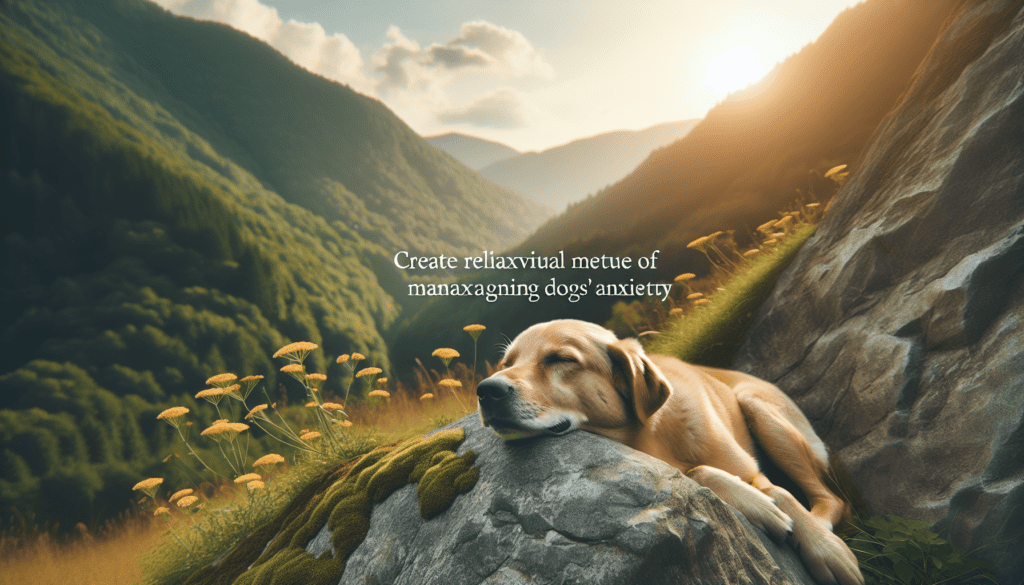If you find that your furry friend is frequently overwhelmed with anxiety, you may be wondering if there are any effective relaxation techniques that can help them find some peace. Well, you’re in luck! This article explores the possibility of using relaxation techniques, such as deep breathing, to benefit anxious dogs. Just like humans, dogs can experience anxiety and stress, and finding ways to help them relax is essential for their well-being. So, let’s take a closer look at how deep breathing and similar techniques can have a positive impact on our anxious canine companions.

Introduction
Having an anxious dog can be a challenging experience for both you and your furry friend. Fortunately, there are several relaxation techniques that can help alleviate your dog’s anxiety and create a more peaceful environment. In this article, we will explore the various causes and signs of anxiety in dogs, the importance of relaxation techniques, and specific techniques you can practice with your dog. We will also discuss the importance of creating a calm environment, seeking professional help if needed, and provide tips for successfully implementing relaxation techniques. By understanding and implementing these techniques, you can help your anxious dog lead a happier and more relaxed life.
Understanding Anxiety in Dogs
Causes of anxiety in dogs
Anxiety in dogs can stem from a variety of causes. Some common triggers include separation from their owners, changes in environment or routine, loud noises (such as thunderstorms or fireworks), fear of certain situations or people, past trauma or abuse, lack of socialization, and genetic predispositions. Identifying the specific cause of your dog’s anxiety is essential in providing effective relaxation techniques.
Common signs of anxiety in dogs
Anxiety in dogs can manifest in various ways, and it is important to recognize the signs in order to address the issue effectively. Some common signs of anxiety in dogs include excessive barking, trembling or shaking, panting, destructive behavior, pacing, aggression, hiding, loss of appetite, excessive grooming, and restlessness. By observing your dog’s behavior closely, you can determine if they are experiencing anxiety and take steps to help them relax.
Importance of Relaxation Techniques for Anxious Dogs
Relaxation techniques play a crucial role in managing anxiety in dogs. Just as humans benefit from techniques like deep breathing and meditation, dogs can also experience relief from anxiety through similar practices. These techniques help dogs calm their minds, regulate their breathing, and release muscle tension. By incorporating relaxation techniques into your dog’s daily routine, you can help them achieve a state of calmness and reduce anxiety levels.
Deep Breathing as a Relaxation Technique
How deep breathing can benefit anxious dogs
Deep breathing is a simple yet effective relaxation technique that can greatly benefit anxious dogs. When dogs become anxious, their breathing becomes shallow and rapid, which can further exacerbate their anxiety. Deep breathing exercises can help regulate their breathing, increase oxygen flow, and activate the body’s relaxation response. This technique promotes relaxation and can help reduce anxiety in dogs.
Steps to practice deep breathing with dogs
To practice deep breathing with your dog, find a quiet and comfortable space where you both can relax. Sit or lie down next to your dog, placing one hand on their chest and the other on their belly. Take a slow, deep breath through your nose, counting to four, while simultaneously feeling your dog’s chest and belly rise. Hold the breath for a few seconds, and then release it slowly through your mouth, again counting to four, feeling your dog’s chest and belly fall. Repeat this process several times, ensuring that your dog is comfortable and relaxed throughout the exercise.

Other Relaxation Techniques for Anxious Dogs
In addition to deep breathing, there are several other relaxation techniques that can benefit anxious dogs. These techniques work in various ways to help dogs manage their anxiety and promote a sense of calmness. Some effective techniques include progressive muscle relaxation, massage therapy, aromatherapy, music therapy, and exercise.
Progressive muscle relaxation
Progressive muscle relaxation involves tensing and relaxing different muscle groups in the body. This technique helps dogs release tension and promotes a state of relaxation. To practice progressive muscle relaxation, gently hold and release each muscle group, starting from the head and moving down to the tail. This technique can be particularly useful for dogs that exhibit signs of muscle tension or restlessness when anxious.
Massage therapy
Massage therapy is a soothing technique that can help dogs relax and reduce anxiety. By gently massaging your dog’s muscles and applying light pressure, you can help release tension and induce a sense of calmness. Massage therapy for dogs can be as simple as petting and stroking them, or you can learn specific techniques from a professional dog massage therapist.
Aromatherapy
Aromatherapy involves using essential oils to create a calming environment for anxious dogs. Certain essential oils, such as lavender and chamomile, have relaxing properties that can help reduce anxiety in dogs. However, it is important to note that not all essential oils are safe for dogs, and some can be toxic. Consult with a veterinarian or a certified aromatherapist to ensure you are using safe and appropriate essential oils for your dog.
Music therapy
Music therapy has been found to have a soothing effect on dogs and can help reduce anxiety levels. Playing soft, calming music or classical music can create a relaxing atmosphere for your dog. There are even specially designed music tracks and playlists available that are specifically composed to calm anxious dogs. Experiment with different types of music to find what works best for your furry friend.
Exercise
Regular exercise is an important part of managing anxiety in dogs. Physical activity helps release endorphins, which are natural mood boosters. Engaging in activities such as walking, playing fetch, or participating in agility courses can help redirect your dog’s anxious energy and promote relaxation. Aim for at least 30 minutes of exercise per day, depending on your dog’s breed and energy level.
Creating a Calm Environment
Reducing noise and visual stimuli
Creating a calm environment for your anxious dog involves minimizing noise and visual stimuli that may trigger their anxiety. Reduce loud noises by closing windows, using white noise machines, or providing a safe and quiet space for your dog. Additionally, eliminate or gradually introduce potentially triggering visual stimuli, such as other animals or people, to help your dog feel more at ease.
Providing a safe and comfortable space
Having a designated safe and comfortable space is vital for anxious dogs. This can be a crate, a specific room, or a cozy bed where your dog can retreat when they are feeling anxious. Make this space inviting by providing soft bedding, familiar toys, and a source of comforting natural light. Encourage your dog to use this space by associating it with positive experiences and rewards.
Establishing a routine
Routine is essential for anxious dogs as it provides structure and predictability. Establishing a consistent daily routine for your dog can help reduce their anxiety levels. Set regular times for meals, exercise, playtime, and relaxation. Dogs thrive on routine and knowing what to expect can contribute to a sense of security and comfort.
Using calming pheromone products
Calming pheromone products, such as sprays or diffusers, emit synthetic pheromones that mimic the natural pheromones dogs produce to communicate calmness and security. These products can help create a calming environment for your dog. Consider using calming pheromone products in areas where your dog spends the most time or during situations that may trigger their anxiety, such as thunderstorms or fireworks.
Professional Help and Medications
Consulting a professional dog trainer or behaviorist
If your dog’s anxiety is severe or persists despite your best efforts, it may be beneficial to seek professional help. A professional dog trainer or behaviorist can provide guidance and techniques tailored to your dog’s specific needs. They can assess your dog’s behavior, provide behavior modification strategies, and offer additional resources to help manage your dog’s anxiety effectively.
Medications for dogs with severe anxiety
In some cases, medication may be necessary to manage severe anxiety in dogs. Your veterinarian can prescribe medications specifically designed for treating anxiety in dogs. These medications can help regulate neurotransmitters in the brain and reduce the severity of anxiety symptoms. It is important to consult with a veterinarian before starting any medication, as they will determine the appropriate dosage and monitor your dog’s response to the medication closely.
Tips for Successfully Implementing Relaxation Techniques
Patience and consistency
Implementing relaxation techniques requires patience and consistency. It may take time for your dog to become accustomed to the techniques and for their anxiety levels to decrease. Be patient with your dog and continue practicing the techniques regularly. Consistency is also key to helping your dog establish a routine and feel more secure.
Positive reinforcement
Using positive reinforcement techniques can help reinforce the desired behavior in your dog. Reward your dog with treats, praise, or playtime whenever they exhibit calm and relaxed behavior. This positive association will motivate your dog to engage in the relaxation techniques and make them more effective over time.
Gradual exposure to triggers
When practicing relaxation techniques, it is important to gradually expose your dog to their triggers. Start with low-intensity situations and gradually increase the exposure as your dog becomes more comfortable and relaxed. This gradual approach helps your dog build confidence and reduces the likelihood of overwhelming them.
Adjusting techniques based on individual dog’s needs
Each dog is unique, and what works for one may not work for another. Pay attention to your dog’s individual needs and adapt the relaxation techniques accordingly. Some dogs may require more or less stimulation, different scents, or specific types of music. Be flexible and open to trying different techniques until you find what works best for your dog.
Potential Limitations and Considerations
Not all dogs will respond the same way
It is essential to keep in mind that not all dogs will respond the same way to relaxation techniques. Dogs have their own personalities and preferences, so what may work for one dog may not work for another. It may require some trial and error to find the most effective techniques for your specific dog. Be patient and observant, and be willing to adjust your approach if needed.
Possible underlying medical conditions
While relaxation techniques can be beneficial for most anxious dogs, it is crucial to consider the possibility of underlying medical conditions. Some medical conditions, such as thyroid imbalances or hormonal disorders, can manifest as anxiety-like symptoms in dogs. If your dog’s anxiety persists or worsens despite relaxation techniques, it is important to consult with a veterinarian to rule out any underlying medical conditions.
Consulting a veterinarian before trying new techniques
Before trying any new techniques or introducing new products, it is always a good idea to consult with a veterinarian. They can provide valuable insights and ensure that the techniques or products are safe and appropriate for your dog. A veterinarian can also offer guidance on how to incorporate relaxation techniques into your dog’s overall healthcare plan.
Conclusion
Managing anxiety in dogs requires patience, understanding, and the implementation of effective relaxation techniques. By recognizing the causes and signs of anxiety in dogs, understanding the importance of relaxation techniques, and creating a calm environment, you can help your anxious dog live a happier and more relaxed life. Remember to tailor the techniques to your dog’s specific needs, seek professional help if necessary, and be consistent in practicing relaxation techniques. With time and dedication, you can make a positive impact on your dog’s well-being and provide them with the peace and comfort they deserve.

